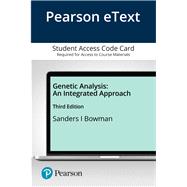DIGITAL UPDATE available for Fall 2021 classes
Engage students with real-world applications of genetics
Informed by more than 50 years of experience and experimentation in teaching genetics, authors Mark Sanders and John Bowman share their excitement about genetics and the dynamism at work in the field with Genetic Analysis: An Integrated Approach. The authors use an integrated approach to help contextualize three core challenges of learning genetics: solving problems, understanding the connection between traditional genetics models and more modern approaches, and understanding evolution.
With the 3rd Edition, the authors provide students with additional problem solving guidance and a new emphasis on real-world applications of genetics. They also strive to make learning the details of genetics easier and offer ways to facilitate group work and discussion of genetics problems and concepts. The revision incorporates key updates that keep pace with changes in the field, such as advances in CRISPR-Cas, more discussion of epigenetics and expanded coverage of genomic approaches.
For all introductory genetics courses.
Pearson eText is an easy-to-use digital textbook that you can purchase on your own or instructors can assign for their course. The mobile app lets you keep on learning, no matter where your day takes you — even offline. You can also add highlights, bookmarks, and notes in your Pearson eText to study how you like.
NOTE: This ISBN is for the Pearson eText access card. Pearson eText is a fully digital delivery of Pearson content. Before purchasing, check that you have the correct ISBN. To register for and use Pearson eText, you may also need a course invite link, which your instructor will provide. Follow the instructions provided on the access card to learn more.










